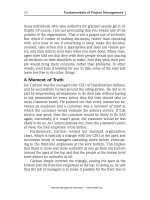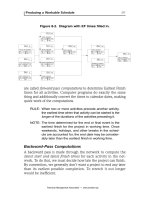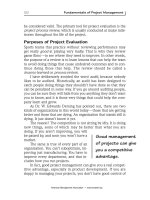IT project management 3rd by THompson chappter 08
Bạn đang xem bản rút gọn của tài liệu. Xem và tải ngay bản đầy đủ của tài liệu tại đây (409.95 KB, 45 trang )
Chapter 8:
Project Quality
Management
Learning Objectives
• Understand the importance of project quality management for
information technology products and services
• Define project quality management and understand how quality
relates to various aspects of information technology projects
• Describe quality planning and its relationship to project scope
management
• Discuss the importance of quality assurance
• List the three outputs of the quality control process
• Understand the tools and techniques for quality control, such as
Pareto analysis, statistical sampling, Six Sigma, quality control
charts, and testing
Learning Objectives
• Describe important concepts related to Six Sigma and how
it helps organizations improve quality and reduce costs
• Summarize the contributions of noteworthy quality
experts to modern quality management
• Understand how the Malcolm Baldrige Award and ISO
9000 standard promote quality in project management
• Describe how leadership, cost, organizational influences,
and maturity models relate to improving quality in
information technology projects
• Discuss how software can assist in project quality
management
Quality of Information
Technology Projects
• Many people joke about the poor quality of IT
products (see cars and computers joke on p.
262)
• People seem to accept systems being down
occasionally or needing to reboot their PCs
• There are many examples in the news about
quality problems related to IT (See What Went
Wrong?)
• But quality is very important in many IT
projects
What Is Quality?
• The International Organization for
Standardization (ISO) defines quality as the
totality of characteristics of an entity that bear
on its ability to satisfy stated or implied needs
• Other experts define quality based on
– conformance to requirements: meeting written
specifications
– fitness for use: ensuring a product can be used as it
was intended
Project Quality Management
Processes
• Quality planning: identifying which quality
standards are relevant to the project and how to
satisfy them
• Quality assurance: evaluating overall project
performance to ensure the project will satisfy the
relevant quality standards
• Quality control: monitoring specific project
results to ensure that they comply with the
relevant quality standards while identifying ways
to improve overall quality
Quality Planning
• It is important to design in quality and
communicate important factors that directly
contribute to meeting the customer’s
requirements
• Design of experiments helps identify which
variables have the most influence on the overall
outcome of a process
• Many scope aspects of IT projects affect quality
like functionality, features, system outputs,
performance, reliability, and maintainability
Quality Assurance
• Quality assurance includes all the activities related
to satisfying the relevant quality standards for a
project
• Another goal of quality assurance is continuous
quality improvement
• Benchmarking can be used to generate ideas for
quality improvements
• Quality audits help identify lessons learned that
can improve performance on current or future
projects
Quality Assurance Plan
Quality Assurance Plan
Quality Control
• The main outputs of quality control are
– acceptance decisions
– rework
– process adjustments
• Some tools and techniques include
–
–
–
–
Pareto analysis
statistical sampling
Six Sigma
quality control charts
Pareto Analysis
• Pareto analysis involves identifying the vital
few contributors that account for the most
quality problems in a system
• Also called the 80-20 rule, meaning that 80% of
problems are often due to 20% of the causes
• Pareto diagrams are histograms that help
identify and prioritize problem areas
Figure 8-1. Sample Pareto
Diagram
Statistical Sampling and Standard
Deviation
• Statistical sampling involves choosing part of a
population of interest for inspection
• The size of a sample depends on how
representative you want the sample to be
• Sample size formula:
Sample size = .25 X (certainty Factor/acceptable error) 2
Table 8-2. Commonly Used
Certainty Factors
Desired Certainty
Certainty Factor
95%
1.960
90%
1.645
80%
1.281
95% certainty: Sample size = 0.25 X (1.960/.05) 2 = 384
90% certainty: Sample size = 0.25 X (1.645/.10)2 = 68
80% certainty: Sample size = 0.25 X (1.281/.20)2 = 10
Six Sigma Defined
• Six Sigma is “a comprehensive and flexible
system for achieving, sustaining and
maximizing business success. Six Sigma is
uniquely driven by close understanding of
customer needs, disciplined use of facts, data,
and statistical analysis, and diligent attention to
managing, improving, and reinventing business
processes.”*
*Pande, Peter S., Robert P. Neuman, and Roland R. Cavanagh, The
Six Sigma Way. New York: McGraw-Hill, 2000, p. xi
Basic Information on Six Sigma
• The target for perfection is the achievement of
no more than 3.4 defects per million
opportunities
• The principles can apply to a wide variety of
processes
• Six Sigma projects normally follow a five-phase
improvement process called DMAIC
DMAIC
• Define: Define the problem/opportunity, process,
and customer requirements
• Measure: Define measures, collect, compile, and
display data
• Analyze: Scrutinize process details to find
improvement opportunities
• Improve: Generate solutions and ideas for
improving the problem
• Control: Track and verify the stability of the
improvements and the predictability of the solution
How is Six Sigma Quality Control
Unique?
• It requires an organization-wide commitment
• Six Sigma organizations have the ability and
willingness to adopt contrary objectives, like
reducing errors and getting things done faster
• It is an operating philosophy that is customerfocused and strives to drive out waste, raise
levels of quality, and improve financial
performance at breakthrough levels
Examples of Six Sigma
Organizations
• Motorola, Inc. pioneered the adoption of Six
Sigma in the 1980s and saved about $14 billion
• Allied Signal/Honeywell saved more than $600
million a year by reducing the costs of
reworking defects and improving aircraft engine
design processes
• General Electric uses Six Sigma to focus on
achieving customer satisfaction
Six Sigma and Project
Management
• Joseph M. Juran stated that “all improvement takes place
project by project, and in no other way”
• It’s important to select projects carefully and apply higher
quality where it makes sense
• Six Sigma projects must focus on a quality problem or gap
between current and desired performance and not have a
clearly understood problem or a predetermined solution
• After selecting Six Sigma projects, the project
management concepts, tools, and techniques described in
this text come into play, such as creating business cases,
project charters, schedules, budgets, etc.
Six Sigma and Statistics
• The term sigma means standard deviation
• Standard deviation measures how much
variation exists in a distribution of data
• Standard deviation is a key factor in determining
the acceptable number of defective units found
in a population
• Six Sigma projects strive for no more than 3.4
defects per million opportunities, yet this
number is confusing to many statisticians
Standard Deviation
• A small standard deviation means that data
cluster closely around the middle of a
distribution and there is little variability among
the data
• A normal distribution is a bell-shaped curve that
is symmetrical about the mean or average value
of a population
Figure 8-2. Normal Distribution
and Standard Deviation
Table 8-3. Six Sigma and Defective
Units









